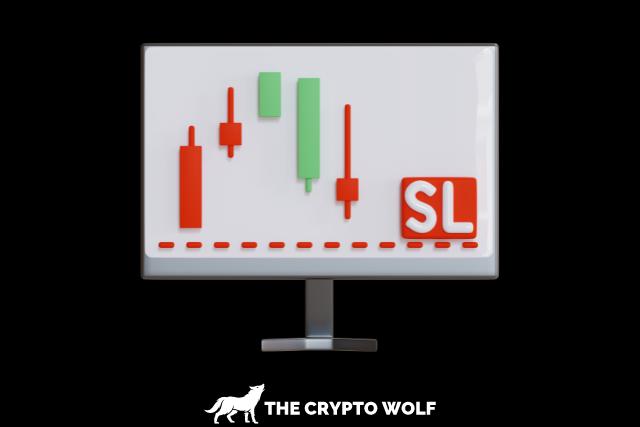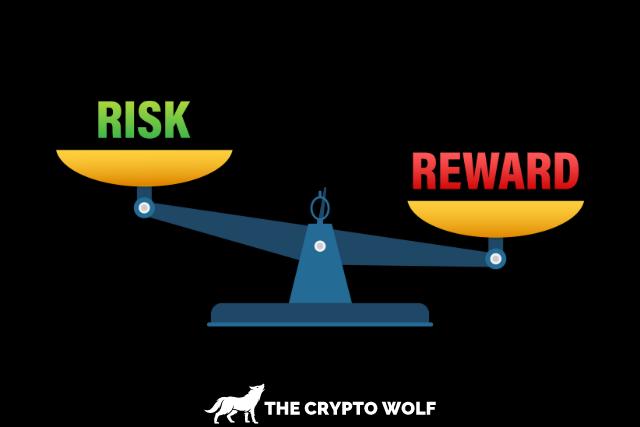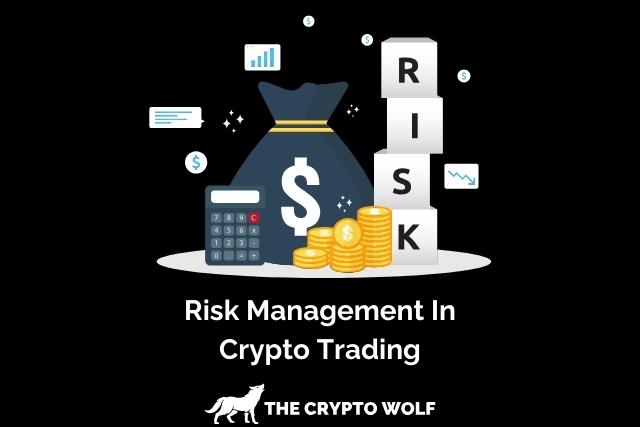When I started crypto trading a few years ago, the first challenge I encountered was managing risk in trading.
The crypto market is very volatile. You can be in profit for one minute and have a considerable loss the next.
A lack of understanding of risk management in trading made me lose three trading accounts, and I stopped trading for over a year before I had the funds to start trading again.
If there’s anything that can significantly impact your trading, it’s risk management. If you lose your capital, you’ll soon be out of trading.
In this article, I will share my risk management psychology, which will help transform how you approach crypto trading.
If you’re ready, let’s dive in
7 Strategies For Risk Management In Crypto Trading
1. Always Use Stop-Loss

Setting stop loss was the most challenging thing I had to learn as a crypto trader due to emotions.
The best way to protect your trading account is to enter every trade with a stop loss in mind.
Deciding on a fixed percentage value will help you become a professional trader.
As a rule, I don’t take more than a 5% loss in a trade, meaning if I open a trade with $100, the maximum loss I can take is $5
The moment I open a trade, I set the stop loss to avoid becoming emotional later and deviating from my trading plan.
Why You Should Use Stop Loss In Crypto Trading
Coin Delisting: most of the crypto exchanges often delist cryptocurrencies that they feel no longer meet their requirements.
Delisting is often bad news for a cryptocurrency, especially if it’s from a major exchange like Binance.
When delisting news is announced, the cryptocurrency can lose up to 60% of its value within a few minutes.
That’s why you need to use stop loss to avoid such situations
Sudden Market Crashes: Another reason for setting stop loss is because of sudden crashes that occur in the crypto market.
Sometimes, when you least expect it, there can be a massive sell-off, which can result in significant losses if you don’t use a stop loss.
How To Set Stop Loss In Crypto Trading
Set the Stop or trigger price: this is the price you want the stop loss to trigger.
Set the Limit price: This is the price at which you want to sell the cryptocurrency. It should be close to the stop price.
When your stop price is triggered, the order to buy or sell at the limit price is placed in the order book.
Although a stop-loss order can be used when buying crypto, most traders use it to sell off their position and minimize their losses.
For instance, if you bought 1 Bitcoin at $35,000, and you don’t want to take a loss more than $200, you can set your stop loss order as follows:
Stop price: $34,801
Limit price: $34,800
What this means is that when Bitcoin gets to $34,801, the exchange will place a limit order for $34,800
2. Diversify Your Portfolio

This is another effective strategy for managing risk in crypto trading. Rather than putting all your funds in one crypto, you can diversify your holdings to reduce risk.
If you have $1000 to trade, you can divide it into two parts and buy different cryptocurrencies with it.
Diversifying your portfolio would ensure you’re not putting all your capital in one cryptocurrency.
This strategy minimizes the impact of losses that arise due to the crypto you choose to trade.
3. Have Predetermined Entry And Exit Points
Most traders make decisions based on emotions, but learning to control your emotions in trading can save you many sleepless nights.
You need to remove the guesswork out of your trading by specifying your entry and exit price.
Avoid being impatient and entering a trade that hasn’t reached your entry price because you feel it’s a good trade and will yield profits.
Most traders do this because they don’t want to miss any opportunity
There are always opportunities in the crypto market that’s why you have to practice being patient and wait for your entry price.
I know it’s difficult, but it’s the best way to position yourself for profit.
Determine your entry and exit price before you open the trade and set the exit price immediately when your position becomes active.
Pro tip: ensure your exit price is not based on greed. My exit price from most trades is 50-100% profit, and my stop loss is always 5%.
4. Beware Of Crypto Gems Hunting
Most YouTube channels keep publishing videos about how to find the next crypto gem that would give you a 100x profit,
I often don’t recommend crypto gem hunting because of the risks involved.
Crypto gem hunting involves finding crypto with a small market cap that’s under the radar and buying it before everyone else,
But the challenge is most of such projects are scams, which makes it easy to lose all your money.
Crypto gem hunting is for traders who have enough funds to keep buying different cryptocurrencies until they find the one that would return significant profits.
Most traders don’t have that kind of money to buy different cryptocurrencies and hope one will return 100x profits.
Crypto gem hunting looks very exciting when you watch it on YouTube, but in reality, it requires quality research and a lot of capital.
5. Position Size Your Trades
There are two ways you can position-size your trades: You can take a certain percentage from your trading capital to buy a cryptocurrency; for instance,
If you have $100, you can take 25% of it and put it in a trade. That way, you will still have funds left to diversify your portfolio.
Another way to position size trades is dollar cost-averaging
Dollar-cost averaging: a trading strategy where you buy a fixed amount of cryptocurrency at different price levels.
For example, you can buy some Bitcoin for $25,500, then $ 22500, etc.
As it goes lower, you buy a fixed amount.
Dollar-cost averaging helps to minimize risk by reducing the total cost of buying the cryptocurrency.
6. Evaluate Your Risk-To-Reward Ratio

Risk to reward ratio is a critical concept in trading that helps you determine if a trade is worth your time.
What Is Risk To Reward Ratio?
Risk-to-reward ratio in crypto trading is a measure used to assess a cryptocurrency’s potential return on investment compared to the level of risk involved in achieving that return.
The risk-to-reward ratio is typically expressed as a numerical ratio, comparing the potential profit (reward) of a trade to the amount of capital put at risk (risk).
For example, if you have a risk-to-reward ratio of 1:2, it means that for every unit of risk you take on, you expect to gain two units of reward.
Here’s How It Works:
If the ratio is 1:1, it means that you are risking one unit of currency to gain one unit of currency; this is considered a balanced risk-to-reward ratio.
If the ratio is greater than 1:1 (e.g., 1:2, 1:3), it means that the potential reward is higher than the risk; this is generally seen as a favourable ratio.
If the ratio is less than 1:1 (e.g., 1:0.5, 1:0.75), it means that the potential reward is lower than the risk; this is considered unfavourable and may indicate that the trade may not be worth pursuing.
How Is Risk To Reward Ratio Calculated
To calculate the risk-to-reward ratio, you need to know the entry price, profit target, and stop loss.
Your reward is calculated as profit target – entry price
While your risk is: entry price – stop loss
For example, let’s say you want to buy Bitcoin at $16500 and think its price will rise to $18000.
So your reward is $1500, and if you decide to put the stop loss at $16000, then the risk is $500.
Your risk/reward ratio for the trade is $500/$1500, which is 1:3
As a rule, you only want to take trades with a 1:3 risk-to-reward ratio, meaning the possibility of making a profit is higher than making a loss.
Frequently Asked Questions
How Much Should I Risk Per Trade In Crypto
You shouldn’t put more than 10% of your total capital in a single trade or take a loss of more than 5% in a trade.
For instance, you have a capital of $1000. You should only put $100 in a trade (10%), and your maximum loss should be $5, which is (5%) of your active trade capital.
Why Is It Difficult To Set Stop Loss In Crypto Trading?
It’s because of the hope that the trade will reverse and go in the direction that will earn you good profits, but in reality, that’s not the case.
You can end up losing everything if you don’t set a stop loss immediately after you enter a trade.
Remember, a slight loss is always better than a big one.
The longer you stay in a losing trade, the harder it becomes to cut your loss.
How Do You Avoid Losses In Crypto Trading?
Stick to your trading plan: desperation for profits can make you take trades that don’t follow your trading plan.
If part of your requirement is to buy crypto at a specific price, don’t be in a hurry to enter a trade because of profit.
Understand support and resistance: If you understand areas of support and resistance, you can buy & sell based on support and resistance, which will help you avoid losses.
Conduct thorough research: Before you buy any cryptocurrency, ensure you conduct thorough research into its ecosystem and understand whether it has a genuine use case and good Tokenomics.
